Meet ajax
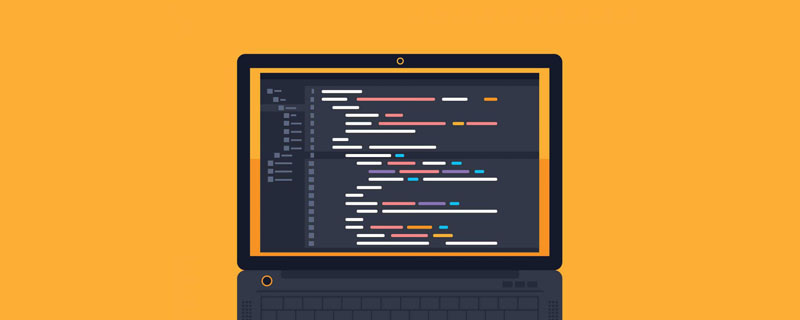
Recommended related articles: ajax video tutorial
##1.1 What is ajax:
Ajax stands for "Asynchronous Javascript And XML" (Asynchronous JavaScript and XML), which refers to a method for creating interactive web applications. Web development technology. Ajax = Asynchronous JavaScript and XML (a subset of Standard Universal Markup Language). Ajax can use web pages to achieve asynchronous updates by exchanging a small amount of data with the server in the background.
- This means that parts of the webpage can be updated without reloading the entire webpage (no refresh technology). Traditional web pages (not using Ajax) must reload the entire web page if the content needs to be updated.
1.2Ajax application scenarios:
1.2.1 Check whether the user name has been registered:Many sites The registration page has a friendly prompt to automatically detect whether the user name exists. The entire page of this function is not refreshed, but data can still be exchanged asynchronously with the server to query whether the user name entered by the user exists in the database.
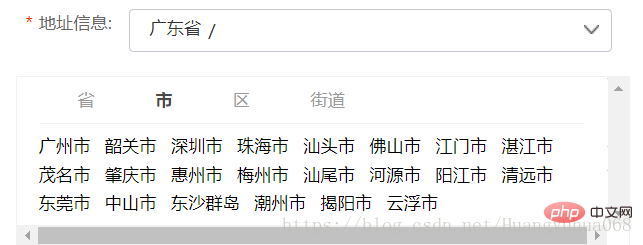

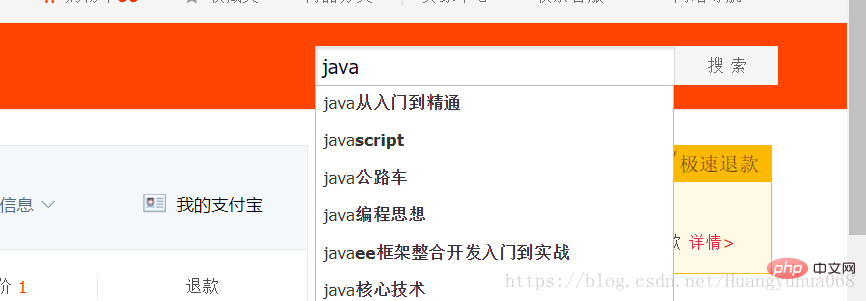
1.3 The difference between synchronous and asynchronous methods :
Send a request in synchronous mode: to send a request, you need to wait for the response to return before you can send the next request. If There is no response to this request and the next request cannot be sent. The client will always be waiting.
- Send a request asynchronously: Send a request without waiting for the response to be returned. You can send the next request at any time, that is, there is no need to wait.
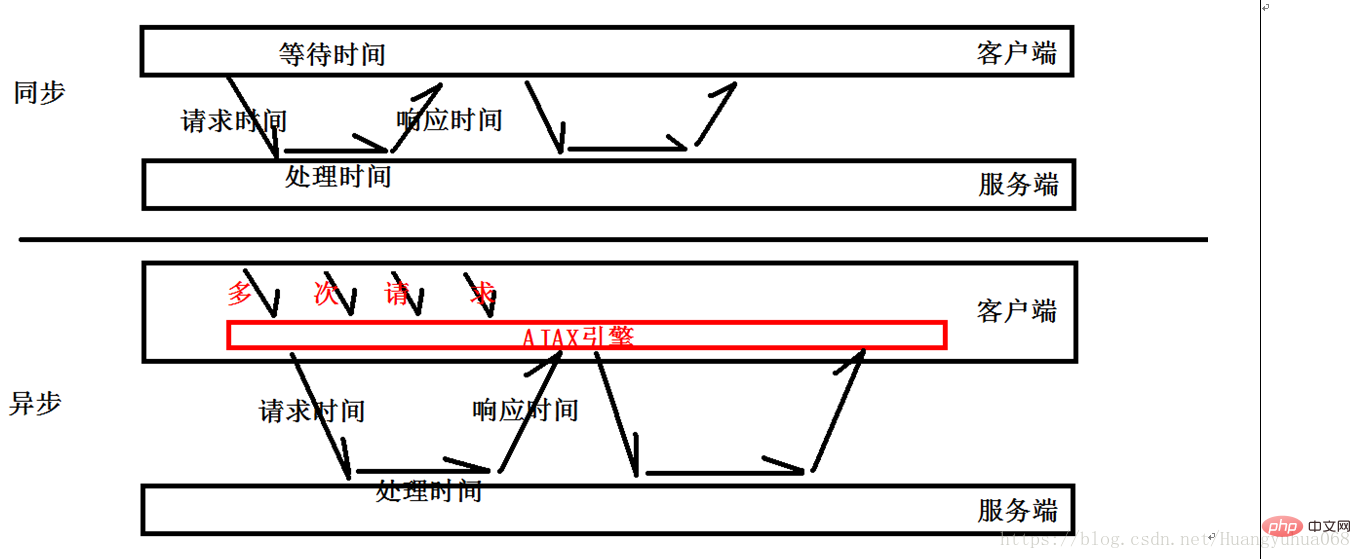
1.4 Ajax Principle Analysis:

- The AJAX engine will send an asynchronous request without refreshing the browser address bar :
Use JavaScript to obtain the browser's built-in AJAX engine (XMLHttpRequest object)
- Use js to determine the request path and request parameters
- The AJAX engine object is based on the request path and request parameters Make a request to send
- The server receives the request from the Ajax engine and processes it:
Server Obtain request parameter data
- The server processes the request business (calling the business layer code)
- The server responds with data to the Ajax engine
- The Ajax engine obtains the data responded by the server and updates the data to the specific location of the browser page by executing the JavaScript callback function :
By setting the callback to the Ajax engine The function obtains the data of the server response
- Use JavaScript to display the response data at the specified location, thereby partially modifying the data of the page to achieve the purpose of partial refresh.
2.1js native Ajax:
js native Ajax development steps:
CreateAjaxEngine Object
Bind listening for the Ajax engine object (the listening server has responded with data to the engine)
Bind submission address
Send request
Listen to process the response data
1 2 3 4 5 6 7 8 9 10 11 12 13 14 15 16 17 18 19 20 21 22 23 24 25 26 27 28 29 30 31 32 33 34 35 36 37 38 39 40 41 42 43 44 45 46 47 48 49 50 51 52 53 54 |
|
1 2 3 4 5 6 7 8 9 10 11 12 13 14 15 16 17 18 19 20 21 22 23 24 25 26 |
|
2.2 Ajax engine connection status readyState value 0~4 change process:
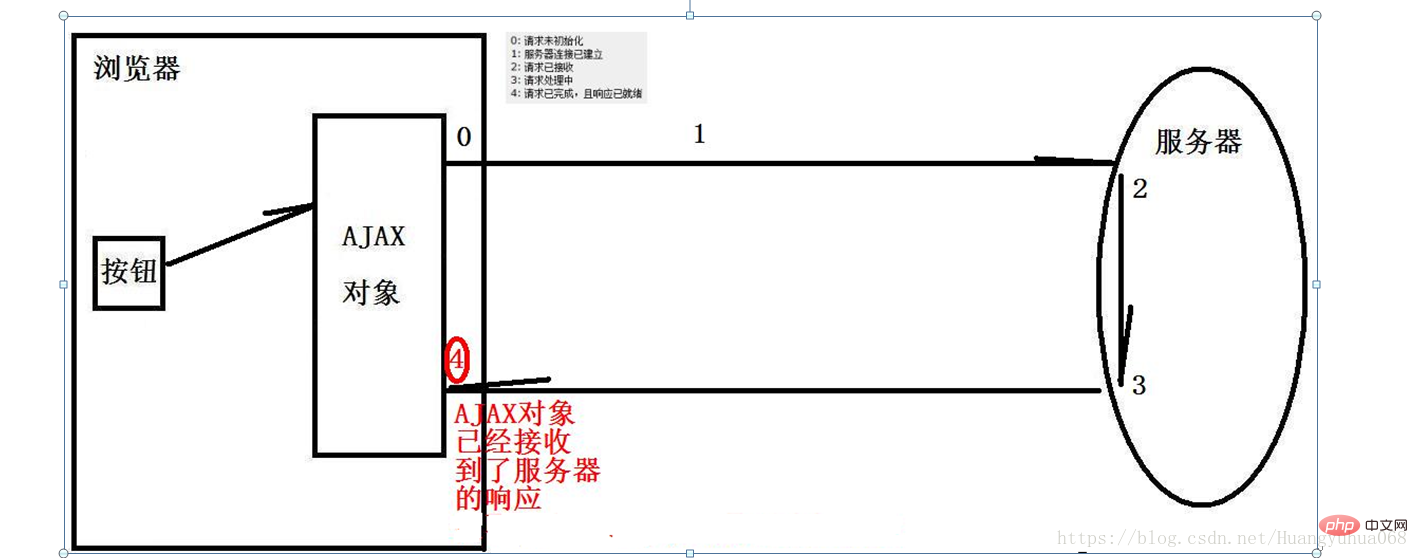
- Stores the status of XMLHttpRequest. Changes from 0 to 4.
- 0: The request is not initialized
- 1: The server connection has been established
- 2: The request has been received
- 3: The request is being processed
- 4: The request has been completed and the response is ready
The status value 4 here can only indicate that the server's response has been received and the server has completed processing the ajax request, but it does not mean that the server's response has been correctly obtained. Response, needs to match the http status code 200. Two conditions can indicate that the server response is correctly obtained. Only when these two conditions are met, xmlhttp.responseText can obtain the correct response data.
1 2 3 4 5 6 7 |
|
Related learning recommendations: javascript learning tutorial
The above is the detailed content of Meet ajax. For more information, please follow other related articles on the PHP Chinese website!

Hot AI Tools

Undresser.AI Undress
AI-powered app for creating realistic nude photos

AI Clothes Remover
Online AI tool for removing clothes from photos.

Undress AI Tool
Undress images for free

Clothoff.io
AI clothes remover

Video Face Swap
Swap faces in any video effortlessly with our completely free AI face swap tool!

Hot Article

Hot Tools

Notepad++7.3.1
Easy-to-use and free code editor

SublimeText3 Chinese version
Chinese version, very easy to use

Zend Studio 13.0.1
Powerful PHP integrated development environment

Dreamweaver CS6
Visual web development tools

SublimeText3 Mac version
God-level code editing software (SublimeText3)

Hot Topics
 How to solve the 403 error encountered by jQuery AJAX request
Feb 20, 2024 am 10:07 AM
How to solve the 403 error encountered by jQuery AJAX request
Feb 20, 2024 am 10:07 AM
Title: Methods and code examples to resolve 403 errors in jQuery AJAX requests. The 403 error refers to a request that the server prohibits access to a resource. This error usually occurs because the request lacks permissions or is rejected by the server. When making jQueryAJAX requests, you sometimes encounter this situation. This article will introduce how to solve this problem and provide code examples. Solution: Check permissions: First ensure that the requested URL address is correct and verify that you have sufficient permissions to access the resource.
 PHP and Ajax: Building an autocomplete suggestion engine
Jun 02, 2024 pm 08:39 PM
PHP and Ajax: Building an autocomplete suggestion engine
Jun 02, 2024 pm 08:39 PM
Build an autocomplete suggestion engine using PHP and Ajax: Server-side script: handles Ajax requests and returns suggestions (autocomplete.php). Client script: Send Ajax request and display suggestions (autocomplete.js). Practical case: Include script in HTML page and specify search-input element identifier.
 How to solve jQuery AJAX request 403 error
Feb 19, 2024 pm 05:55 PM
How to solve jQuery AJAX request 403 error
Feb 19, 2024 pm 05:55 PM
jQuery is a popular JavaScript library used to simplify client-side development. AJAX is a technology that sends asynchronous requests and interacts with the server without reloading the entire web page. However, when using jQuery to make AJAX requests, you sometimes encounter 403 errors. 403 errors are usually server-denied access errors, possibly due to security policy or permission issues. In this article, we will discuss how to resolve jQueryAJAX request encountering 403 error
 How to solve the problem of jQuery AJAX error 403?
Feb 23, 2024 pm 04:27 PM
How to solve the problem of jQuery AJAX error 403?
Feb 23, 2024 pm 04:27 PM
How to solve the problem of jQueryAJAX error 403? When developing web applications, jQuery is often used to send asynchronous requests. However, sometimes you may encounter error code 403 when using jQueryAJAX, indicating that access is forbidden by the server. This is usually caused by server-side security settings, but there are ways to work around it. This article will introduce how to solve the problem of jQueryAJAX error 403 and provide specific code examples. 1. to make
 How to get variables from PHP method using Ajax?
Mar 09, 2024 pm 05:36 PM
How to get variables from PHP method using Ajax?
Mar 09, 2024 pm 05:36 PM
Using Ajax to obtain variables from PHP methods is a common scenario in web development. Through Ajax, the page can be dynamically obtained without refreshing the data. In this article, we will introduce how to use Ajax to get variables from PHP methods, and provide specific code examples. First, we need to write a PHP file to handle the Ajax request and return the required variables. Here is sample code for a simple PHP file getData.php:
 PHP vs. Ajax: Solutions for creating dynamically loaded content
Jun 06, 2024 pm 01:12 PM
PHP vs. Ajax: Solutions for creating dynamically loaded content
Jun 06, 2024 pm 01:12 PM
Ajax (Asynchronous JavaScript and XML) allows adding dynamic content without reloading the page. Using PHP and Ajax, you can dynamically load a product list: HTML creates a page with a container element, and the Ajax request adds the data to that element after loading it. JavaScript uses Ajax to send a request to the server through XMLHttpRequest to obtain product data in JSON format from the server. PHP uses MySQL to query product data from the database and encode it into JSON format. JavaScript parses the JSON data and displays it in the page container. Clicking the button triggers an Ajax request to load the product list.
 PHP and Ajax: Ways to Improve Ajax Security
Jun 01, 2024 am 09:34 AM
PHP and Ajax: Ways to Improve Ajax Security
Jun 01, 2024 am 09:34 AM
In order to improve Ajax security, there are several methods: CSRF protection: generate a token and send it to the client, add it to the server side in the request for verification. XSS protection: Use htmlspecialchars() to filter input to prevent malicious script injection. Content-Security-Policy header: Restrict the loading of malicious resources and specify the sources from which scripts and style sheets are allowed to be loaded. Validate server-side input: Validate input received from Ajax requests to prevent attackers from exploiting input vulnerabilities. Use secure Ajax libraries: Take advantage of automatic CSRF protection modules provided by libraries such as jQuery.
 What are the ajax versions?
Nov 22, 2023 pm 02:00 PM
What are the ajax versions?
Nov 22, 2023 pm 02:00 PM
Ajax is not a specific version, but a technology that uses a collection of technologies to asynchronously load and update web page content. Ajax does not have a specific version number, but there are some variations or extensions of ajax: 1. jQuery AJAX; 2. Axios; 3. Fetch API; 4. JSONP; 5. XMLHttpRequest Level 2; 6. WebSockets; 7. Server-Sent Events; 8, GraphQL, etc.






